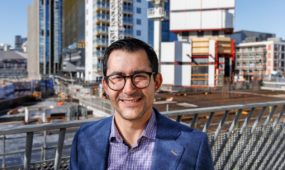Natural glue spray to hold dental evidence together
Health & Medical
A natural glue spray that can bind and stabilise incinerated facial remains has the potential to significantly improve the ability to positively identify burns victims.

Sign up to receive notifications about new stories in this category.
Thank you for subscribing to story notifications.
A forensic dentist in Adelaide, South Australia is working with a manufacturer to develop a product he hopes will become a standard item in police forensic kits around the world.
Dr John Berketa, from the University of Adelaide Forensic Odontology Unit, was motivated to try to make a difference after witnessing first hand the grim reality of the bushfires that devastated parts of Victoria in 2009.
More than 170 people perished and, as is often the case in such disasters, many could only be identified through their dental records. However, in many cases their facial remains were damaged or became separated while the bodies were being transported, making the process more difficult and more time consuming.
“We had photos taken at the scene and when we compared them with the bodies that had been transported there were often quite significant differences,” Dr Berketa said.
That is a problem because it is not just the teeth themselves that can help with identification, particularly if there are no dental records and comparisons have to be made with photographs. Forensic teams look at the distance between the teeth and the shape and structure of the entire jaw.
It is possible to recreate the mouth and jaw if all the pieces are available, but it is hard to be absolutely accurate and, as Dr Berketa puts it, you get to the stage where you are “expressing an opinion” on how it might have looked.
He saw that the answer lay in creating a special glue that would form a protective cast over the entire jaw. Surprisingly, no such product exists, though there are records of people dabbling with super glue.
“To be effective you need a product you can spray on, because the motion of brushing it on would be disruptive, and it has to be a natural product that won’t contaminate the remains or interfere with x-rays,” he said. “Anything using petrochemicals is out.”
Over two years Dr Berketa tested a range of commercially available natural glues, initially on a cigarette resting on a tile – “I figured if I could hold cigarette ash in place I was on the right track”, he said – and then on sheep heads.
The best option still needed modification to ensure it was the best it could be, and he is now talking with the manufacturer about creating a product that would be ready to use.
In the meantime, he is already working with South Australian Police (SAPOL), training officers how to mix and correctly apply the stabilising spray.
SAPOL, the Coroners Court and Forensic Science SA have all been involved with the research, and Dr Berketa has been able to test his processes at disaster scenes, with impressive results.
Jump to next article



